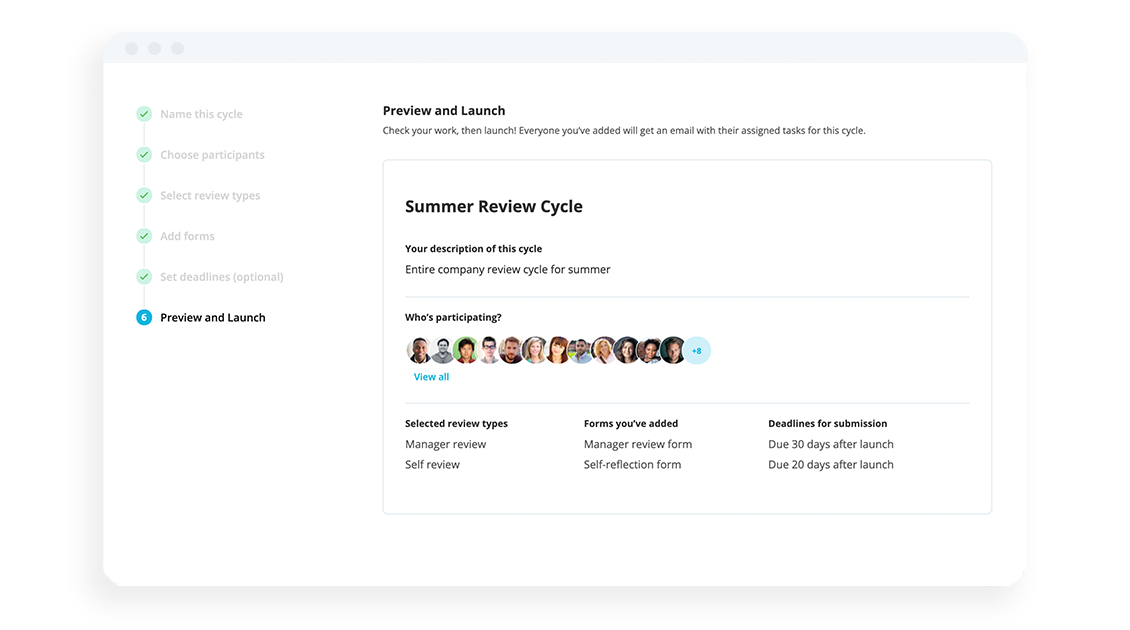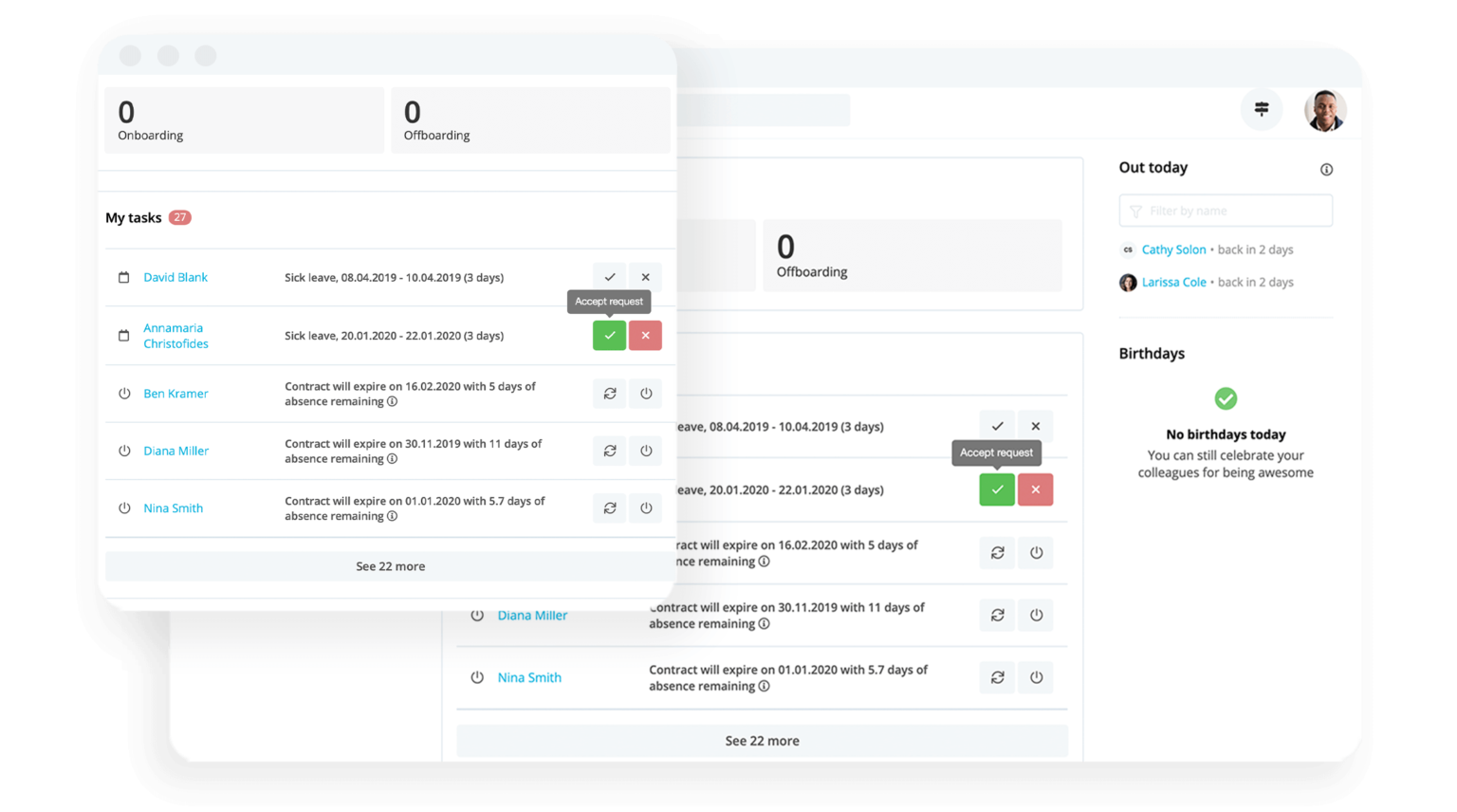
Performance Management Software
Simplify how you deliver your next performance review cycle.
Learn moreIs Job Rotation A Win-Win For Employees and Employers?

Can job rotation programs break a pattern of waning productivity in your workforce? In this article, we offer a thorough look into job rotation as a concept, its benefits, and how to build a rotation program that makes sense for your employees.
Looking to build your own people strategy? Feel free to try our guide on for size.What Is Job Rotation?
Job rotation is like corporate musical chairs, but more beneficial—and with more strategy. In a job rotation program, employees work in a variety of different positions and departments within the company instead of sticking to one specific role.
How Long Does A Job Rotation Last?
In some programs, the employee will work in another role temporarily to learn new skills before returning to their original position. In others, the employee uses the job rotation to transition into a different department or area of the business.
Employees will typically make lateral moves within the same department so it's easier for them to slide into the role. For example, you wouldn’t move an employee from an entry-level position into a leadership position.
But let’s say an employee was interested in moving from Sales to Marketing. They could then rotate through each marketing position to assess where their skills fit best before joining the team.
How Often Does Job Rotation Occur In Companies?
Some companies rotate once per quarter to give employees a well-rounded experience in various departments. Other companies have job rotation programs that you have to apply to and be approved for.
How Do Job Rotation Programs Help Employees?
There’s a certain excitement that comes with starting a new job. You’re constantly learning new things, developing your skills, and growing more confident in your abilities.
But over time, a position that once felt exciting can begin to feel stale and monotonous.
Job rotation programs inject a new sense of excitement and discovery into the employee experience to keep them engaged, motivated, and onboard with the company.
Moreover, it offers fresh new perspectives and experiences to employees to help them better understand their company, become more engaged in their work, and develop their careers.
Let’s take a closer look at the benefits of job rotations for employees:
Employees Develop Their Skills
A new role equals new skills to be learned and mastered. Job rotations encourage career development, help employees upskill, and improve your talent pool’s overall quality. Plus, it often helps employees feel more confident in their role and gain more knowledge of the company overall.
In one study, 89.6% of employees felt that job rotation fulfilled their need to gain various skills. As a bonus, 96% of them also said they became more productive 89.6% became better problem-solvers.
Employees Become More Motivated And Engaged
Only half of UK workers are engaged in their work, and that’s likely due to boredom or lack of motivation. When employees have out-skilled their positions but are unable to move up in the company, a lateral move via job rotation can keep them motivated and engaged.
They’re getting the challenge and development they desire in their day-to-day work but can remain in the comfort and security of their current workplace.
Employees Discover Their True Strengths
Your employee could thrive in another position but just not know it yet. If they’re not reaching their full potential in their role or aren’t completely satisfied, a job rotation can help them discover their strengths and find a better-suited position.
Trainees Are Placed More Effectively
In a similar vein, job rotation works well in trainee positions where newcomers can experience a wide variety of roles within the company. This can help employees determine where their skills fit best, and employers can see where they add the most value.
Automated Performance Cycles With Personio

Keep track of employee development, even during job rotation, by automatically scheduling performance cycles to run on their own. This way, managers and employees can focus on productivity and not processes.
Drive Performance Higher With PersonioHow Job Rotation Helps Employers
While their employees are soaking up all their new experiences and skills, their employers are reaping the benefits. While implementing a job rotation program is a big undertaking, it can lead to fantastic long-term gains for organizations, including:
Lower Employee Attrition
The UK has the third-highest risk of attrition, with 23% of employees intending to stay at their companies for less than a year.
Many of today’s workers will leave a role due to a lack of career development opportunities or boredom. But through job rotation programs, you can keep them more engaged and aligned with the company mission, making them feel valued.
A More Flexible And Adaptable Workforce
Right now, what would happen if an employee suddenly quits? Or took a sick day when their workload was mounting?
You’d need to cover their work or fill their role, fast.
By having employees rotate through the jobs in their department (and beyond), you’ll have more people with the skills and knowledge to help—and it will be easier for your employees, too. In one instance, 67.7% of employees who rotated through roles said it made them better at coping with changes in the business.
An Improved Overall Culture
Through job rotations, employees can meet new people and become more familiar with peers they otherwise wouldn’t have worked with, creating a more comfortable and open working environment.
You’ll Build Better Leaders
Before a manager moves up to leadership, they can experience many different roles and departments and gain a comprehensive understanding of the inner workings of the company, the people, and the pain points, helping them be more in-tune leaders.
Keep Track Of Every HR-Related Tasks

Personio offers a bird’s eye view of every important HR task. Teams can also set up reminders to ensure deadlines are never missed and goals are always met. Learn more about it today.
Task Management With PersonioHow Job Rotation Can Go Wrong
As beneficial as job rotations are for employees and employers, there’s still a lot that can go wrong if everyone isn’t prepared for the process:
If You Don’t Provide Clear Guidance…
Employees and managers alike can feel adrift in an ever-changing workplace. Everyone involved must receive clear guidance on the process, expectations, and goals of their job rotation to maximize the outcome.
If Some Employees Aren’t On Board…
It can get rough. Some employees may be fine just where they are and may not want to shake up their routines or have others disrupt their tried-and-true processes. Making job rotations mandatory can amplify these feelings, so you may want to go with an opt-in rotation program instead.
If You’re Not Ready To Invest…
The amount of time and money that goes into creating and implementing a job rotation program may overwhelm you. You need to spend time and resources training employees and managers on this new process and account for the impact it may have on your bottom line.
If It’s Not Right For Your Business…
It can easily lead to frustrated customers or clients who wonder, "Why am I always dealing with a different person?” It can also lead to errors, as employees are continuously learning, therefore making mistakes.
8 Steps To Building And Implementing A Job Rotation Process
To help minimize any issues, draft a clear and strategic job rotation process for your team. Here’s a nine-step process you can follow (and build on) to create and implement your job rotation process:
1. Establish Guidelines
First, create guidelines for the managers and employees involved in the process. Establishing best practices for each job rotation experience will ensure both parties know what’s expected of them. Take this time to help employees and employers set their expectations: What are the employer’s expectations? What does the employee want to gain from the experience (new skills, a new job, etc.)?
2. Design Your Rotation Path
The job rotation program should be built to satisfy the company’s goals and speak to the overall business plan. Start by detailing the company’s short- and long-term goals, the current employee roster, and the organization’s growth plan.If you plan on hiring a lot of new employees, have a number of employees retiring soon, or have a lot of departments or employees that need support, it will impact your job rotation program.
Next, decide which positions within each department will rotate with each other, and consider the following:
Will employees need to go through the different positions in a specific order?
What training is needed for each role, and how long will it take?
What are the most important parts of each job?
How long does the employee need in the role to be generally competent in it?
Who will take on the rotating employee’s previous responsibilities or role?
How many rotations can happen at the same time across the company and within each department?
Build Programs That Suit Your People

Don’t just implement an employee training program, build a strategy around your people designed to unleash their potential, cater to their needs, and stand the test of time. Download our guide to creating them today.
Have A Look Now3. Set Goals and KPIs
Next, determine how you’ll measure a successful job rotation. Success can mean different things for different roles, depending on your goal for the employee. They may want to acquire specific skills, move along in their career path, or use this time to transition to another department.
4. Get Employee Buy-In
Not every employee may be completely on board with the idea of job rotations. Suppose this is a new concept for your team. In that case, it’s even more important that you clearly explain the process and benefits, provide rewards or incentives, and position it as a positive opportunity to learn new skills that can help them grow in their career.
5. Assess Employee Talents
Before an employee is rotated into a new role, conduct a talent assessment. This will help you determine what transferable skills they already have and what skills they’ll need to focus on developing in their new role. It also provides a more tailored experience for the employee, which can help them feel more valued and supported.
6. Establish Training
Training should be well established before an employee rotates onto a team so they can optimize their experience there.Working backward may help:
What is the employee’s goal?
What tasks and projects will help them reach that goal?
What essential training do they need to complete to work on those tasks and projects successfully?
Many companies will pair the rotating employee with a coach, mentor, or buddy from their new department so they have one-on-one guidance along the way. You may also need to train the team the employee will be joining so they can step into their role seamlessly and not disrupt their established workflow.
7. Provide Ongoing Support
Everyone involved will need support at one point or another, be it the employee, their mentor, their new team, or their original team. Set expectations early on but also be prepared to problem-solve, fill roles, manage changing workloads, and keep everyone up to date with the timelines and goals as necessary.
8. Measure Your Success
Conduct skills assessments on the employee throughout the process to see how their experience is going and what you can improve along the way. Then, conduct a final assessment at the end to measure their skill improvements, determine if they met their goals, and evaluate their overall experience.
At this point, you can also outline the employee’s next steps, whether they’re rotating to a new position, transferring departments, or going back to their original position.
To Rotate, Or Not To Rotate…
So, is job rotation truly effective for employees and employers?
It very easily can be. The key is to establish a clear process and guidelines for those involved, clearly communicate the benefits to ensure team buy-in, and continually assess the programs so they remain valuable to the employee and organization.
Disclaimer
We would like to inform you that the contents of our website (including any legal contributions) are for non-binding informational purposes only and does not in any way constitute legal advice. The content of this information cannot and is not intended to replace individual and binding legal advice from e.g. a lawyer that addresses your specific situation. In this respect, all information provided is without guarantee of correctness, completeness and up-to-dateness.
